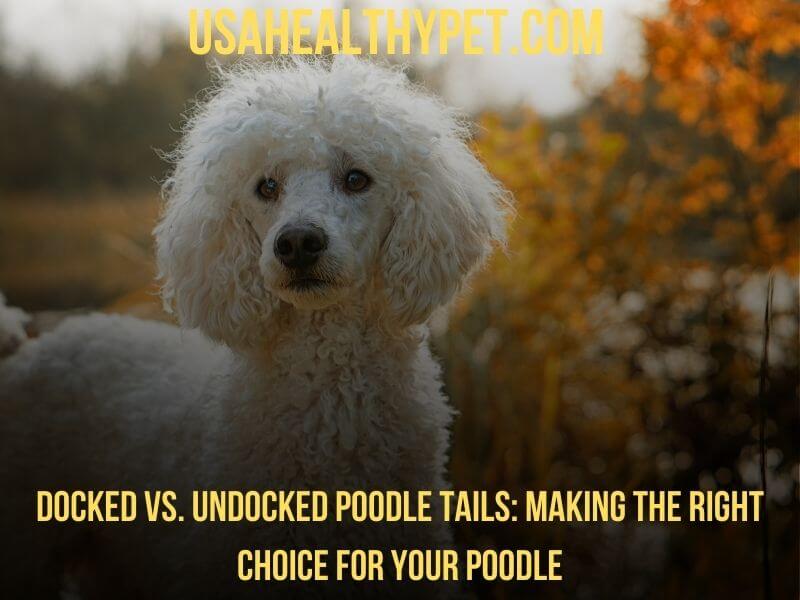Thinking about whether to dock your Poodle’s tail or let it stay natural? It’s a question many dog owners ponder. Let’s dive into the topic of Poodle Tails – docked vs. undocked – and weigh the pros and cons.
By the end of this chat, you’ll have a clear idea of what might be best for your furry friend.
What is Poodle Tail Docking?
First things first, what exactly is tail docking? Tail docking is a surgical procedure where a portion of a dog’s tail is removed.
This practice dates back centuries and has been used for various reasons, from practical to aesthetic.
For poodles, tail docking typically happens when they are just a few days old. The goal is often to achieve a specific look that aligns with breed standards.
Why Do Some Poodles Get Their Tails Docked?
Now, you might be wondering, why go through the trouble of docking a poodle’s tail? The reasons are a mix of tradition, aesthetics, and practical considerations.
Historical Reasons
Historically, tail docking was believed to prevent rabies, strengthen the back, and increase speed. While these reasons don’t hold much water today, they did influence the practice.
Breed Standards
For poodles, particularly in the show ring, a docked tail has often been the norm. Breed standards established by kennel clubs have traditionally called for a docked tail, contributing to the widespread practice.

Practical Considerations
For working dogs, a docked tail can prevent injuries. Poodles, originally bred as water retrievers, could suffer from tail injuries while working. Docking was seen as a preventative measure.
Aesthetic Preferences
Many people dock their poodle’s tail simply because they prefer the look. It’s a matter of personal taste and what they believe fits the breed’s image.
The Humane Society of the United States opposes cosmetic tail docking and encourages people to consider the welfare of the animal over aesthetic preferences.
Poodle Tail Docked Vs Undocked
Pros and Cons of Docked Tails
The American Veterinary Medical Association (AVMA) opposes cosmetic tail docking of dogs, stating that it causes unnecessary pain and distress. They recommend leaving tails undocked unless medically necessary.
Like any decision, there are pros and cons to docking a poodle’s tail. Let’s break them down.
Pros
| Pros of Docked Tails | Explanation |
|---|---|
| Prevents Injuries | Docking can prevent tail injuries in working dogs. |
| Breed Standards | Aligns with traditional breed standards for show dogs. |
| Aesthetics | Some owners prefer the look of a docked tail. |
| Hygiene | Easier to keep clean, especially for water retrievers. |
Cons
| Cons of Docked Tails | Explanation |
|---|---|
| Pain and Discomfort | The procedure can cause pain and discomfort for the puppy. |
| Ethical Concerns | Many argue it’s unnecessary and cruel. |
| Communication | Dogs use their tails for communication; docking can hinder this. |
| Surgical Risks | As with any surgery, there are risks involved. |
Pros and Cons of Undocked Tails
The American Kennel Club (AKC) acknowledges the tradition of tail docking in certain breeds and leaves the decision to dock a tail to the discretion of breeders and owners. They maintain that the practice, when performed properly, is acceptable.
On the flip side, let’s consider the pros and cons of leaving a poodle’s tail undocked.
Pros
| Pros of Undocked Tails | Explanation |
|---|---|
| Natural Appearance | Retains the dog’s natural look. |
| No Pain | Avoids the pain and discomfort of docking. |
| Better Communication | Dogs can use their tails to express emotions. |
| Ethical Choice | Considered more humane by many. |
Cons
| Cons of Undocked Tails | Explanation |
|---|---|
| Potential Injuries | Higher risk of tail injuries, especially for working dogs. |
| Maintenance | Longer tails may require more grooming and care. |
| Breed Standards | May not meet traditional breed standards for show dogs. |
| Aesthetic Preferences | Some owners may prefer the look of a docked tail. |

What is the Poodle Breed?
Before we go any further, let’s take a quick detour to appreciate the poodle breed itself. Poodles are known for their intelligence, elegance, and versatility. They come in three sizes: Standard, Miniature, and Toy.
Originally bred in Germany as water retrievers, poodles have a rich history and a distinctive look. Their curly, hypoallergenic coats and impressive trainability make them a popular choice for many dog lovers.
Are Poodles’ Tails Supposed to Be Docked?
Dr. Jane Smith DVM strongly opposes tail docking for cosmetic purposes. She emphasizes that “Tail docking is an elective surgery that poses risks of complications such as infection and improper healing. Dogs communicate using their tails, and removing this part of their body can hinder their ability to express themselves.”
Tail docking is a practice rooted in old traditions that no longer hold much practical value today. Unless you’re aiming to show your Poodle in AKC competitions where a docked tail is a requirement, opting for a Poodle with an undocked tail is a great choice.
Remember, an undocked tail needs regular grooming to prevent matting and keep it looking fabulous.
PETA is firmly against tail docking, calling it a painful and unnecessary procedure. They argue that it serves no benefit to the dog and should be banned.

Is Tail Docking Illegal?
The legality of tail docking varies widely depending on where you are. In some countries, tail docking is banned or heavily restricted.
For example, the United Kingdom and many European countries have laws against docking unless it’s for medical reasons.
In the United States, laws vary by state. Some states have restrictions, while others leave it up to the owner’s discretion. It’s important to check local regulations before deciding to dock a poodle’s tail.
How Is a Poodle’s Tail Docked?
So, how is tail docking actually done? The procedure is typically performed when puppies are between 2 and 5 days old. Here’s a step-by-step rundown:
- Preparation: The puppy is taken to a veterinarian who will assess its health.
- Anesthesia: Local anesthesia may be used to numb the area.
- Docking: The vet will use a sterile instrument to remove a portion of the tail.
- Aftercare: The tail is bandaged, and the puppy is monitored for any signs of infection or discomfort.
The entire process is quick, but it’s not without its risks and ethical concerns. Many vets and animal welfare organizations advocate against it unless there is a clear medical reason.
Final Decision: Docked or Undocked Tails?
So, what’s the final word on whether you should dock your poodle’s tail? It ultimately comes down to personal preference, lifestyle, and beliefs. If you’re planning to show your poodle in competitions where docked tails are preferred, you might lean towards docking.
However, if you’re more concerned about your dog’s comfort and well-being, leaving the tail undocked could be the way to go.
Consider the pros and cons, consult with your vet, and think about what feels right for you and your furry friend. Remember, your poodle will be fabulous and loving no matter what their tail looks like!
We’ve covered a lot of ground today, from the ins and outs of tail docking to the opinions of major animal welfare organizations. Whether you choose a docked or undocked tail for your poodle, the most important thing is that your pup is healthy, happy, and loved.
FAQs
1. Is tail docking painful for puppies?
Yes, tail docking can cause pain and discomfort for puppies, even though it’s done at a very young age.
2. Can an adult poodle’s tail be docked?
Tail docking is typically done on very young puppies. Docking an adult dog’s tail would be more complex and is generally not recommended unless for medical reasons.
3. Does tail docking affect a poodle’s behavior?
Tail docking can impact a dog’s ability to communicate using its tail, but it doesn’t typically affect overall behavior.
4. How long does it take for a docked tail to heal?
Healing can take a few weeks. It’s important to monitor the tail for signs of infection and ensure it stays clean.
5. Are there alternatives to tail docking?
Yes, alternatives include leaving the tail natural or addressing any specific medical issues with appropriate treatments rather than docking.

Pingback: Understanding Pembroke Corgi Tails: Natural vs. Docked Tails
Pingback: Top 5 Dog Breeds with Zig-Zag on Tail: Key Traits and Care